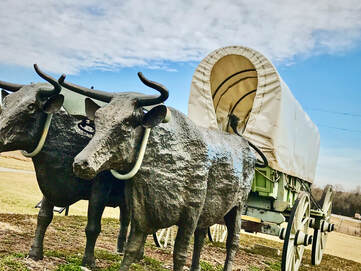OREGON TRAIL PARK
|
Thousands of pioneers forged westward in their quest to a new life in Oregon in the 1800's. Along the way, their wagon tracks and legacy camped in this area along Scott Springs, just south of current-day Westmoreland, on the east side of Highway 99. The land was deeded to Pottawatomie County by descendents of the Scott family for 100 years for $1.00. Just a one mile walk from the Museum Complex, visitors can enjoy a scenic foot trail that leads to the perfect picnic place, equipped with restrooms and a shelter that is handicap accessible.
|
Ernest and Della White of Westmoreland
constructed the oxen and wagon. |
LITTLE DOG LOST WALKING TRAIL
As you visit the complex, you'll want to be sure and take the Little Dog Lost Trail from the Museum grounds to the Oregon Trail Park. Spanning one mile in length, this handicap accessible one mile trail is named after the little dog who, after sitting all day waiting for his family to return, was taken in by locals who cared for him. The little dog became known as "Mike," but after giving birth to a litter of puppies, it was discovered that "Mike" was a female! "Mike" was locally famous.
As the number of cars that were driving by and sometimes stopping to visit the dog and her pups continued to climb, the Kansas Department of Transportation requested the dog family be relocated for safety reasons. A local resident moved the little dog and her family to town and had no problem finding homes for the pups.
As the number of cars that were driving by and sometimes stopping to visit the dog and her pups continued to climb, the Kansas Department of Transportation requested the dog family be relocated for safety reasons. A local resident moved the little dog and her family to town and had no problem finding homes for the pups.
HAND-DUG WELL
As many as forty men labored through the winter months and early spring of 1914 on Westmoreland's city water well. At the time, there was no modern machinery to aid in their efforts. These men used picks and shovels to dig a well that would supply a town with water. Westmoreland's hand-dug well is the second largest in the state of Kansas.
HISTORIC RESIDENCES
Cochrun House - earliest surviving residence in Westmoreland (1882)
J.H. Cooper residence (1883)
M.E. Beal residence (1885)
H. L. Gard residence (1883)
Elizabeth McKee residence (1895)
Grand Army of the Republic building - now a private residence (1885)
J.H. Cooper residence (1883)
M.E. Beal residence (1885)
H. L. Gard residence (1883)
Elizabeth McKee residence (1895)
Grand Army of the Republic building - now a private residence (1885)
HISTORIC BUSINESS AND PUBLIC BUILDINGS
An online map is coming soon!
Pottawatomie Courthouse
This building is the second oldest courthouse in the state of Kansas and is on the National Register of Historic Places.
Former Westmoreland Grade School - This building now serves as the Pottawatomie County Office Building.
The Old Robson Brothers Department Store
Old Star Drugstore
Old Reyers Jewelry Store
Gas Lamp in Mini Park
Shriners Loan Office (1883)
City Meat Market (1885)
City Hall - formerly a pump house for the hand-dug well
Entrance Pillars to Legion Park
Pottawatomie Courthouse
This building is the second oldest courthouse in the state of Kansas and is on the National Register of Historic Places.
Former Westmoreland Grade School - This building now serves as the Pottawatomie County Office Building.
The Old Robson Brothers Department Store
Old Star Drugstore
Old Reyers Jewelry Store
Gas Lamp in Mini Park
Shriners Loan Office (1883)
City Meat Market (1885)
City Hall - formerly a pump house for the hand-dug well
Entrance Pillars to Legion Park
